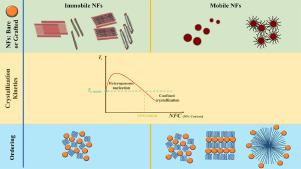Progress in Polymer Science ( IF 27.1 ) Pub Date : 2022-03-01 , DOI: 10.1016/j.progpolymsci.2022.101527 Abdullah S. Altorbaq 1 , Alejandro A. Krauskopf 1 , Xiangning Wen 2 , Ricardo A. Pérez-Camargo 2 , Yunlan Su 2 , Dujin Wang 2 , Alejandro J. Müller 3, 4 , Sanat K. Kumar 1

|
There has been considerable interest in the nucleation and crystallization of polymers in the presence of nanoparticles (NPs, or nanofillers in general, NFs). Most of the extensive work in this area has focused on anisotropic, non-Brownian NFs (e.g., clay sheets, carbon nanotubes) whose spatial dispersion state in these nanocomposites is controlled by the process by which they are formed. Hence, NF spatial dispersion is generally limited and often remains poorly characterized. Thermodynamic handles that can be used to control NF dispersion state in the polymer melt include (a) favorable interactions between the polymer chains and the bare NP surfaces, or (b) the density and length of the chains, with the same chemistry as the matrix, grafted to the NP surface. These relatively large NFs merely act as stationary objects that affect the kinetics of nucleation by providing heterogeneous sites, and the crystallization rate by confining the polymer in the melt state. The dispersion state of the NFs can dramatically affect the nucleation and crystallization of the matrix, but in most cases reported, the NFs increase nucleation efficiency relative to the neat polymer. At higher NF loadings, the effect of polymer confinement by the NFs dominates, leading to a decrease in crystal growth rates. This review describes the most important lessons learned from these commonly studied systems and then extends to polymer composite systems containing small, mobile spherical NPs (typically smaller than 100 nm in size).
The role of NP mobility, which provides for dynamic confinement of the polymer melt, on the kinetics of polymer crystallization (nucleation, growth, and overall crystallization) and how this behavior is mostly consistent with the case of immobile NF is a second important focus of this review. In addition to the role of NFs on crystallization kinetics, recently reported nanoparticle ordering phenomena such as the effect of matrix crystallization on the organization of small spherical NPs within the amorphous regions of the semicrystalline morphology are discussed. Such phenomena are clearly not observed for large NFs and hence provide a point of departure from past works in this area.
中文翻译:

半结晶聚合物纳米复合材料中的结晶动力学和纳米粒子排序
在存在纳米颗粒(NPs,或一般的纳米填料,NFs)的情况下,聚合物的成核和结晶引起了相当大的兴趣。该领域的大部分广泛工作都集中在各向异性的非布朗 NFs(例如粘土片、碳纳米管)上,它们在这些纳米复合材料中的空间分散状态由它们形成的过程控制。因此,NF 空间色散通常是有限的,并且通常仍然很难表征。可用于控制聚合物熔体中 NF 分散状态的热力学控制包括 (a) 聚合物链和裸露的 NP 表面之间的有利相互作用,或 (b) 链的密度和长度,具有与基质相同的化学性质, 接枝到 NP 表面。这些相对较大的 NF 仅充当静止物体,通过提供异质位点来影响成核动力学,并通过将聚合物限制在熔融状态来影响结晶速率。NFs 的分散状态可以显着影响基体的成核和结晶,但在大多数情况下,NFs 相对于纯聚合物提高了成核效率。在较高的 NF 负载下,NF 对聚合物的限制作用占主导地位,导致晶体生长速率下降。这篇综述描述了从这些常用研究系统中吸取的最重要的经验教训,然后扩展到包含小型、可移动的球形 NP(通常小于 100 nm 尺寸)的聚合物复合系统。以及通过将聚合物限制在熔融状态的结晶速率。NFs 的分散状态可以显着影响基体的成核和结晶,但在大多数情况下,NFs 相对于纯聚合物提高了成核效率。在较高的 NF 负载下,NF 对聚合物的限制作用占主导地位,导致晶体生长速率下降。这篇综述描述了从这些常用研究系统中吸取的最重要的经验教训,然后扩展到包含小型、可移动的球形 NP(通常小于 100 nm 尺寸)的聚合物复合系统。以及通过将聚合物限制在熔融状态的结晶速率。NFs 的分散状态可以显着影响基体的成核和结晶,但在大多数情况下,NFs 相对于纯聚合物提高了成核效率。在较高的 NF 负载下,NF 对聚合物的限制作用占主导地位,导致晶体生长速率下降。这篇综述描述了从这些常用研究系统中吸取的最重要的经验教训,然后扩展到包含小型、可移动的球形 NP(通常小于 100 nm 尺寸)的聚合物复合系统。NFs 对聚合物的限制作用占主导地位,导致晶体生长速率下降。这篇综述描述了从这些常用研究系统中吸取的最重要的经验教训,然后扩展到包含小型、可移动的球形 NP(通常小于 100 nm 尺寸)的聚合物复合系统。NFs 对聚合物的限制作用占主导地位,导致晶体生长速率下降。这篇综述描述了从这些常用研究系统中吸取的最重要的经验教训,然后扩展到包含小型、可移动的球形 NP(通常小于 100 nm 尺寸)的聚合物复合系统。
为聚合物熔体提供动态限制的 NP 迁移率对聚合物结晶动力学(成核、生长和整体结晶)的作用以及这种行为如何与固定 NF 的情况基本一致是第二个重要的焦点这篇评论。除了 NFs 对结晶动力学的作用外,还讨论了最近报道的纳米颗粒有序现象,例如基质结晶对半结晶形态的无定形区域内小球形 NPs 组织的影响。对于大型 NF,显然没有观察到此类现象,因此提供了与该领域过去工作的一个出发点。



























 京公网安备 11010802027423号
京公网安备 11010802027423号